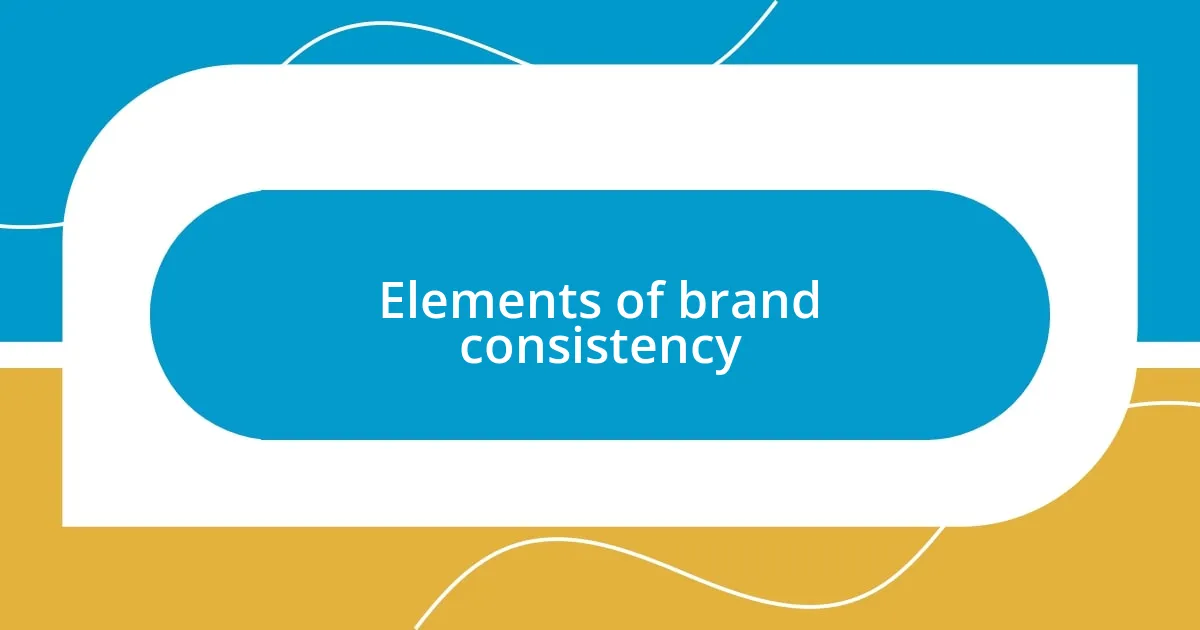Key takeaways:
- Brand consistency is essential for building trust and recognition, impacting customer decisions and loyalty.
- Key elements include visual identity, tone of voice, customer experience, and consistent messaging across all platforms.
- Strategies for maintaining consistency include creating a detailed brand style guide, regular team training, and utilizing technology for oversight.
- Common mistakes to avoid include neglecting visual identity, failing to engage staff with brand values, and overcomplicating messaging.

Understanding brand consistency
Brand consistency is more than just having a matching logo or color palette; it reflects the identity and values of a company across all touchpoints. I remember working with a client whose brand seemed strong at first glance, but upon closer inspection, the messaging and visuals varied widely across their channels. This inconsistency left customers confused and questioning who they really were.
When I think about brand consistency, I see it as a promise to the customer. Have you ever walked into a coffee shop expecting the same warm, cozy vibe from your favorite location only to find something completely different at another branch? Experiencing this disparity can make you feel disconnected and even distrustful of the brand. It drives home the point that what’s communicated must align with the experience provided to foster lasting relationships.
In my opinion, brand consistency serves as a guiding principle for all marketing efforts. It’s about creating a cohesive narrative that speaks to the audience’s emotions and expectations. I’ve seen brands that excel in this area effortlessly cultivate loyalty, while others falter simply because their messaging is scattered. Isn’t it fascinating how a unified approach can resonate so deeply with customers?

Importance of brand consistency
Brand consistency is crucial because it builds trust and recognition. I recall a time when I was shopping for athletic gear. The first brand I encountered had the same logo and messaging across their website, ads, and in-store displays. This uniformity made me feel confident about their reliability, and I ended up choosing them over a competitor with a disjointed brand presence. I realized then how vital consistent branding can be to influencing customer decisions.
Moreover, maintaining brand consistency can significantly enhance customer loyalty. When I think about brands I admire, their ability to deliver a steady experience is paramount. Just the other day, I wore a jacket from a favorite outdoor brand. The quality and style reminded me why I trust them. It’s experiences like these that reinforce loyalty—customers gravitate towards brands that ensure familiarity and reliability in their messaging and visual identity.
Lastly, I believe that brand consistency helps streamline marketing efforts. When everyone’s on the same page regarding tone, visuals, and messaging, it becomes so much easier to communicate effectively with the audience. I’ve helped clients align their marketing strategies, and it’s incredible to see how that clarity leads to more impactful campaigns. It’s almost like a well-orchestrated performance where each element contributes to a magnificent overall presentation.
| Aspect | Impact |
|---|---|
| Trust & Reliability | Consistent branding fosters a sense of security in customer choices. |
| Customer Loyalty | Unified messaging creates familiarity that fosters long-term relationships. |
| Streamlined Marketing | Clarity in branding simplifies communication across channels. |

Elements of brand consistency
When discussing the elements of brand consistency, I find it intriguing how various elements intertwine to create that cohesive identity. From the tone of voice used in written communication to the visual design on social media, every facet plays a pivotal role. I recall attending a workshop where a speaker emphasized the importance of consistent customer service—a point that struck a chord with me. When a brand’s employees reflect the same values and messaging as their marketing, it creates a seamless experience that truly embodies the brand’s essence.
Here are some essential elements that contribute to brand consistency:
- Visual Identity: Logos, colors, and design styles should remain uniform across all platforms to create instant recognition.
- Tone of Voice: The way a brand communicates—whether playful, professional, or empathetic—should be maintained in all written and spoken interactions.
- Customer Experience: Every touchpoint, from website navigation to customer service interactions, should align with the brand’s core values and promise.
- Messaging: The brand’s key messages must stay consistent, conveying the same fundamental ideas regardless of the medium or context.
I’ve seen firsthand how these elements can converge beautifully. A local bakery I love has a charming, rustic logo that mirrors the warmth you feel when you walk in and are greeted by friendly staff. Their heartfelt social media posts and welcoming aroma of fresh bread create an experience that feels genuine—because it’s reflected in every detail. This consistency not only draws me back but makes me excited to share my experiences with friends. The emotional connection here is palpable, showcasing how cohesive branding resonates on deeper levels.

Strategies for maintaining consistency
To maintain brand consistency effectively, creating a detailed brand style guide is essential. I remember when I worked with a client who struggled with a scattered visual identity. I suggested developing a clear style guide that laid out every detail—from color palettes to typography. This guide not only provided direction but also empowered their team to uphold the brand’s image uniformly. It’s heartening to see how a document can unify and enhance a brand’s overall presence.
Another strategy I find valuable is regular team training. When everyone involved in the brand—from marketing to customer service—inherits a shared understanding of the core values and messaging, it builds a collective commitment to those principles. I often encourage businesses to hold workshops that reinforce these concepts, as I’ve seen how they elevate the team’s engagement levels. After all, don’t we want everyone advocating for the brand with the same passion and knowledge?
Lastly, utilizing technology can ensure that your branding remains cohesive across all digital platforms. I’ve seen brands successfully implement project management tools that help track every marketing piece, maintaining alignment with their branding guidelines. By leveraging such tools, it creates a level of accountability and makes adjustments easier when inconsistencies arise. Isn’t it fascinating how the right technology can simplify the complex process of brand management?

Measuring brand consistency
Measuring brand consistency can often feel like navigating a maze. I remember working on a project for a tech startup where we utilized customer feedback surveys to gauge how well consumers perceived the brand’s identity. It was revealing to see the gaps between customer expectations and actual experiences. The insights not only helped us adjust our messaging but also guided the design of future marketing materials for stronger alignment with our core values.
Another effective approach I’ve found is conducting social media audits. I once led a review for a client where we analyzed their posts over six months. This exercise unearthed a mix of tones and visuals that, although well-intentioned, created confusion among their audience. What struck me was how quickly a few inconsistent elements could derail a well-crafted brand image. It emphasized the need to continuously evaluate our output to stay true to our desired identity.
I also believe in the power of analytics tools to measure brand consistency. Using platforms that track engagement and sentiment around the brand can illuminate how well your messaging is resonating with your audience. For instance, I recall a brand I followed that made a significant pivot in their strategy based on data insights, resulting in a remarkable increase in customer loyalty. Isn’t it fascinating how data can tell a story that drives a brand’s narrative forward?

Common mistakes to avoid
One common mistake I often observe is neglecting the importance of a unified visual identity. I once consulted for a small business that felt comfortable using various logos across different platforms. It seemed innocuous at first, but soon, their audience was confused about which logo represented the actual brand. Can you imagine how disheartening it must be for customers to question their loyalty? Ensuring a consistent visual identity across all touchpoints is crucial to reinforcing brand recognition.
Another pitfall is failing to engage employees in the brand’s mission and values. In one experience, I was part of a brand refresh for a retail company where the marketing team was fully onboard, but the store staff weren’t familiar with the new messaging. This disconnect led to mixed messages being communicated to customers. It’s frustrating to think about the missed opportunities for those staff members to be brand ambassadors! A brand can only thrive when everyone understands the mission and feels invested in it.
Lastly, avoid the trap of overcomplicating brand messaging. I recall advising a tech company that tried to impress their audience with industry jargon and complex terminology. It backfired—customers felt alienated rather than informed. Has anyone ever left a conversation feeling more confused than enlightened? Simplicity is key; clear and concise messaging helps forge stronger connections with your audience.

Case studies of successful brands
One standout example of brand consistency can be seen with Nike. Their motto, “Just Do It,” has been a powerful and recognizable phrase for decades. I remember watching a Nike ad that not only featured athletes but also everyday people pursuing their passions. It hit me how this simple yet powerful messaging resonated universally. Have you ever felt that rush of inspiration when seeing someone conquer a challenge? That’s the impact of cohesive messaging across platforms—Nike encourages everyone to push their limits, and they do it consistently.
Then there’s Apple, renowned for its sleek product design and minimalist branding. I’ve often marveled at how every detail—in their advertising, product packaging, and even the layout of their stores—exudes that signature Apple aesthetic. Each time I walk into an Apple Store, the environment feels like an extension of their brand. It made me realize how crucial it is for brands to create an immersive experience. How engaged do I feel as a customer when everything aligns perfectly with my expectations? It’s a reminder that consistency fosters loyalty and trust.
Lastly, consider Coca-Cola, which has maintained its brand identity through countless campaigns around the world. I recall a holiday season when they launched a campaign showcasing joy and togetherness, seamlessly tying into their long-standing image of happiness. It was heartwarming to see how their consistent values transcended cultural barriers. Does it ever strike you how seemingly simple elements, when consistently executed, can create a powerful emotional connection with consumers? Coca-Cola’s ability to evoke nostalgia while reinforcing their brand message is a testament to the strength of brand consistency.














